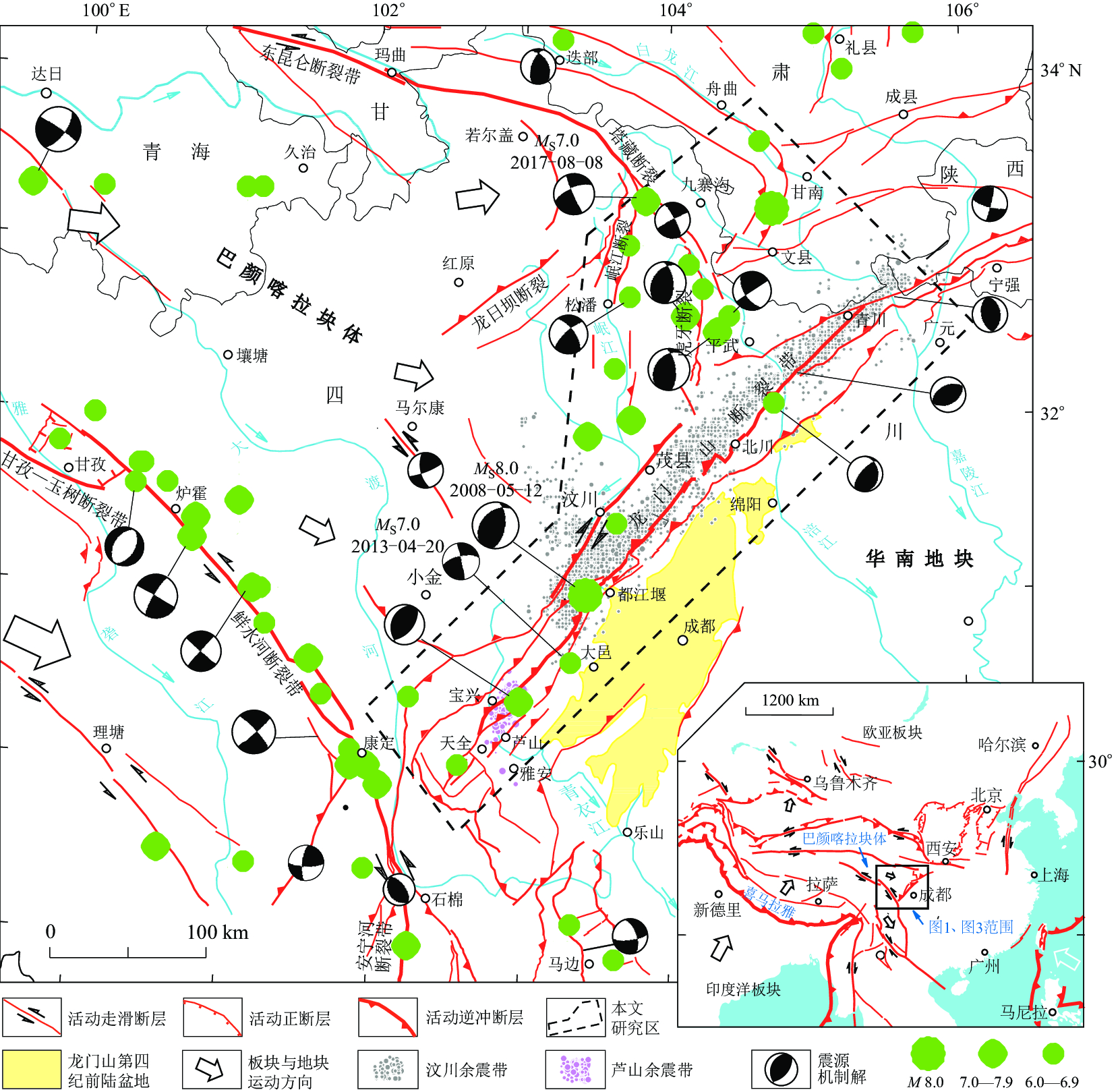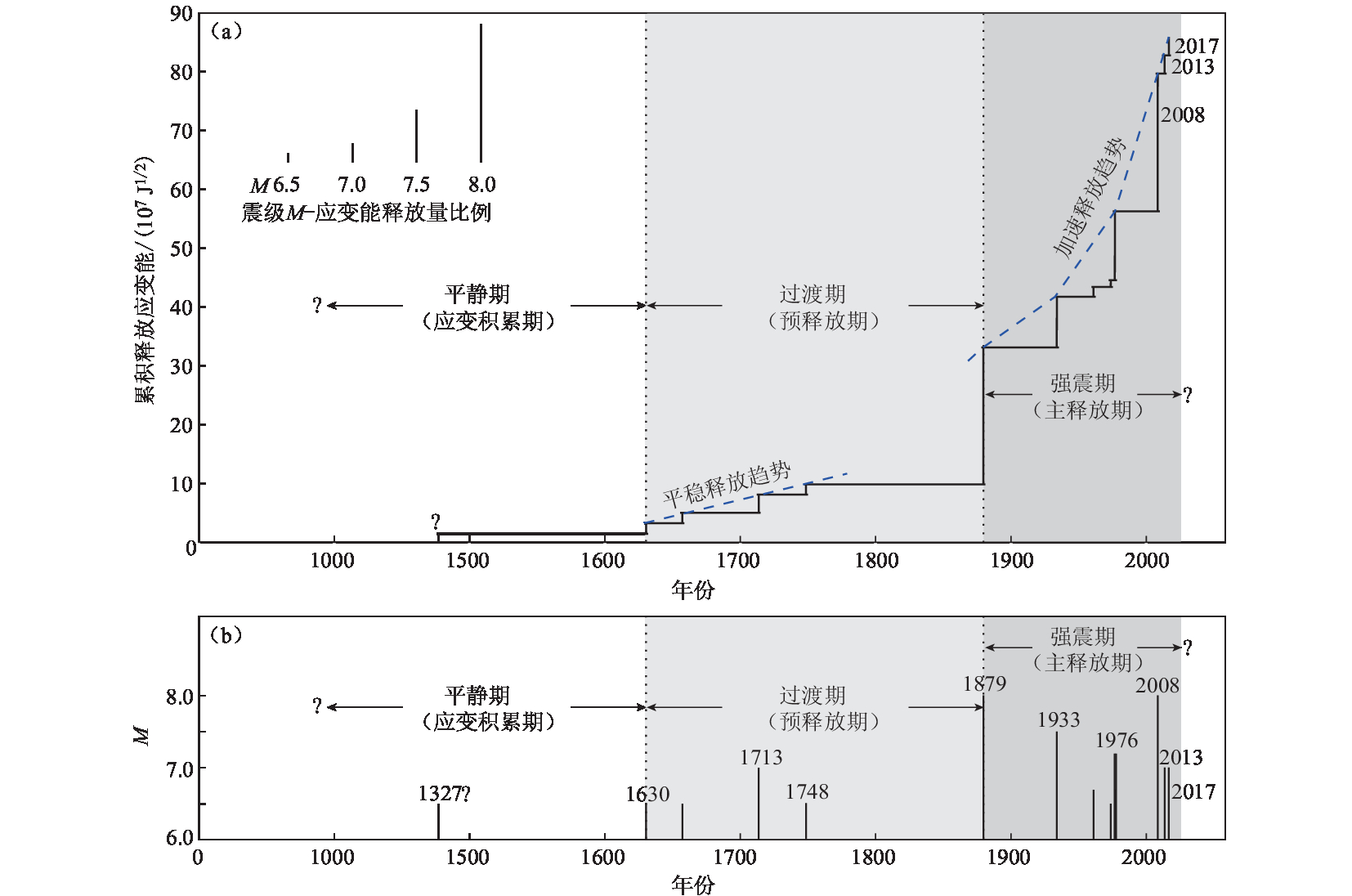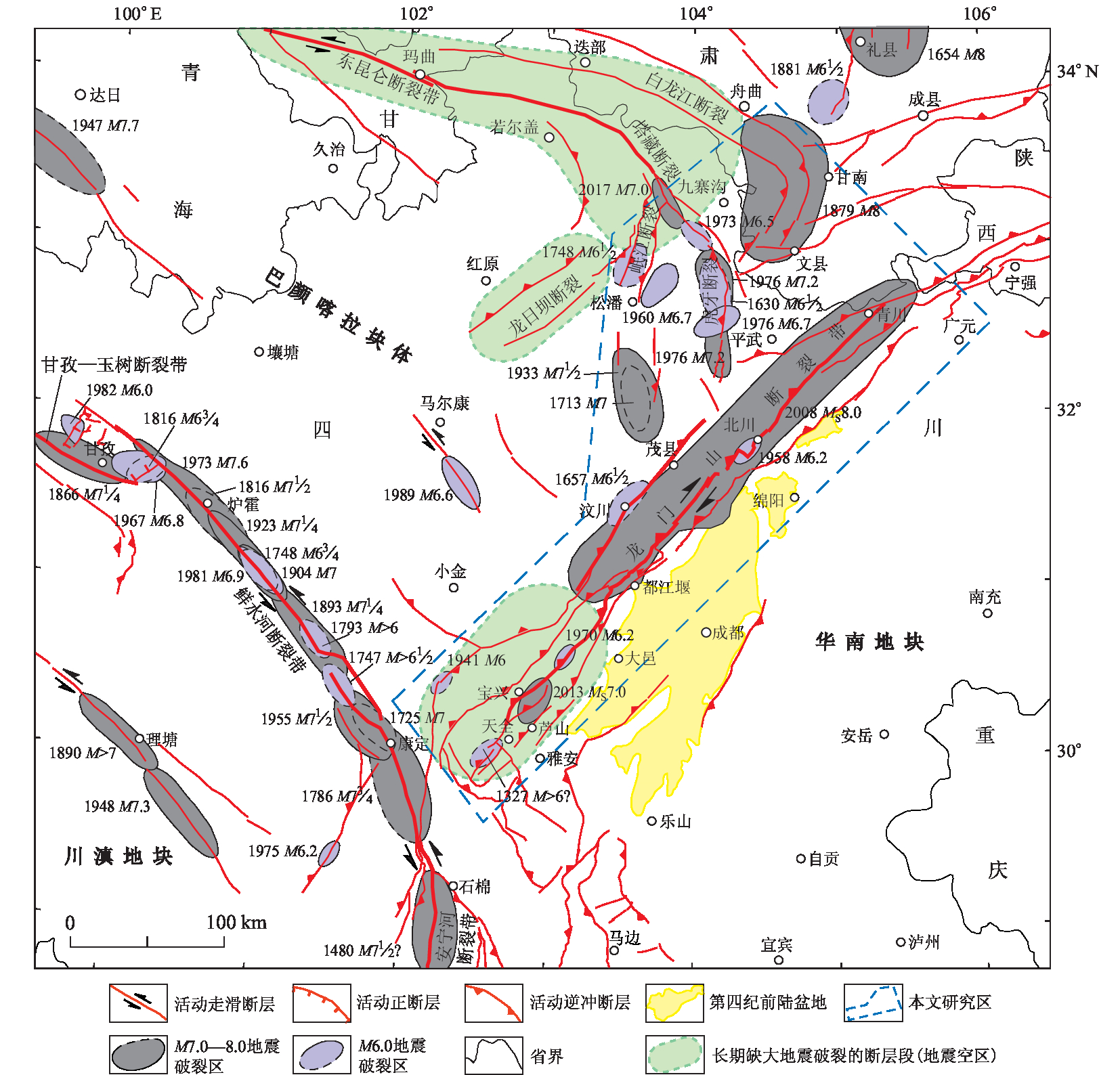The 2008 Wenchuan, 2013 Lushan and 2017 Jiuzhaigou earthquakes, Sichuan, in the last more than one thousand years of rupture history of the eastern margin of the Bayan Har block
-
摘要: 以巴颜喀拉块体东边界活动构造带为研究区,本文首先分析了该区最近一千多年的地震历史及强震活动随时间的变化,确定了2008年汶川MS8.0地震、2013年芦山MS7.0地震和2017年九寨沟MS7.0地震这3次事件在这一强震活动历史中的位置,进而在圈绘长期强震破裂区图像的基础上鉴别主要活动断裂带上的地震空区。结果主要表明:研究区在最近约一千年中经历了一个强震轮回的3个阶段,包括一个平静期的后半部(1630年之前)、1630—1878年之间的过渡期以及1879年以来的强震期。后两个阶段可能代表了该构造带在经过更早、可能二三千年长的平静期或应变积累期之后出现的长达数百年、从“预释放”期(1630—1878年)到“主释放”期(1879年以来)的强震发生过程;在主释放期应变能释放呈明显加速,四川2008年汶川、2013年芦山以及2017年九寨沟地震是发生在主释放期中的3次最新事件,但是由这3次事件的发生还难以判断主释放期是否已经结束;已圈绘出研究区及其邻近地区若干活动断裂段上存在长期缺少大地震破裂的地震空区,未来仍应注意在这些地震空区再次发生大地震的危险性。Abstract: By taking the active tectonic belt along the eastern margin of the Bayan Har block as the study region, this paper first examines the earthquake history over the last 1 000 years and the temporal variation in strong earthquake activity, and determines the temporal positions in this history of the most-recent three major events, the 2008 MS8.0 Wenchuan, 2013 MS7.0 Lushan and 2017 MS7.0 Jiuzhaigou earthquakes. Then, based on mapping historically ruptured areas the author identifies the seismic gaps along main active fault zones in and near the study region. The result mainly shows that the study region has experienced three stages of a strong-earthquake cycle during the last about 1 000 years, including the last half of the quiet period before 1630, the transitional period from 1630 to 1878, and the strong-event occurrence period since 1879. The last two periods together have a total duration of several hundred of years, and probably represent such a seismicity process in which the study active tectonic belt went through from the pre-release episode (between 1630 and 1878) to the main release episode (since 1879), following an earlier quiescence period of probably 2 000 to 3 000 years in length for strain accumulation. Accelerating strain energy release appears obviously in the main release episode. The three events of the 2008 MS8.0 in Wenchuan, 2013 MS7.0 in Lushan and 2017 MS7.0 in Jiuzhaigou, Sichuan, are the most-recent ones occurred in the main release episode. However, it still remains unknown whether the main release episode has closed or not yet after the occurrences of the latest three events. Several seismic gaps are identified and mapped along some segments of the major active fault zones in and near the study region, which have had no ruptures of major earthquakes for long time. So, enough attention should be paid to the seismic potentials for major earthquakes occurring on these seismic gaps in the not far future.
-
-
图 1 巴颜喀拉块体东边界及其邻近地区的活动构造、区域动力学与历史强震背景
余震资料据四川地震台网目录,震源机制解引自哈佛大学CMT目录和闻学泽等(2011)
Figure 1. Map showing active tectonics,regional dynamics and background of historical earthquakes in and near the study region
The dashed frame indicates the position of the study region. Aftershock data are from Sichuan Seismic Network. Focal mechanism solutions are mostly from Harvard CMT catalog and partly from Wen et al (2011)
图 2 研究区累积地震应变能释放-时间图(a)与M-t图(b)
使用1630年之前M≥6.0和1630年以来M≥6.5地震资料
Figure 2. Cumulative strain energy release versus time chart (a) and M-t chart (b) of earthquake activity of the study region
Seismic data of M≥6.0 events for the period before 1630 and of M≥6.5 events for the period since 1630 are used
图 3 研究区及其邻近地区的地震破裂区和地震空区(据闻学泽等(2009)和M7专项工作组(2012) 修改)
破裂区的虚线边表示位置和延伸上存在不确定性
Figure 3. Map of earthquake rupture areas and seismic gaps in and near the study region (modified from Wen et al (2009) and Working Group of M7 (2012))
Positions and extents of the rupture areas with dashed edges are uncertain
表 1 研究区历史地震和现代地震信息(1630年之前M≥5.7,1630年以来M≥6.5)
Table 1 Historical and modern earthquakes of the study region(M≥5.7 events before 1630 and M≥6.5 events since 1630)
编号 发震时间
年-月-日震中位置 M 极震区
烈度记载破坏和
受影响的地点记载的有感地点个数及
有感半径R北纬/° 东经/° 1 −186−02−22 33.8 105.6 6—7? ≥Ⅷ 甘肃陇南(原武都)、舟曲 ≥2 2 278−08−16 ? ? 四川平武与甘肃文县之间 ? 3 638−02−14 32.8 103.4 5¾ 四川松潘以北 ≥2 4 942年冬 ? 摧毁民居百数(未提地点) 1 (四川成都) 5 951年冬 ? 民居摧毁者百余所
(未提地点)1 (四川成都) 6 1004−03−23 ? ? 3 (雅安、汉源、成都) 7 1327−09−? 30.1 102.7 ≥6 四川天全附近 6 (四川天全、成都,陕西凤翔、汉中,湖北宜昌、江陵),R≥950 km 1 1630−01−16 32.6 104.1 6½ Ⅷ 四川松潘与平武之间 9 (四川盆地内),R>450 km 2 1657−04−21 31.3 103.5 6½ Ⅷ 四川汶川、茂县等4地 14 (四川盆地内),R>400 km 3 1713−09−04 32.0 103.7 7 Ⅸ 四川茂县与松潘之间 9 (四川盆地内),R>230 km 4 1748−05−02 32.8 103.7 6½ >Ⅶ 四川松潘北 1 (靠近九寨沟) 5 1879−07−01 33.2 104.7 8 Ⅺ 甘肃陇南、文县与四川
九寨沟之间>70,R>1 200 km 6 1933−08−25 31.9 103.4 7½ Ⅹ 四川茂县北 >30,R>550 km 7 1960−11−09 32.7 103.7 6.7 Ⅸ 四川松潘北 ? 8 1973−08−11 32.9 103.9 6.5 ≥Ⅶ 四川松潘北东 9,R>250 km 9−1 1976−08−16 32.6 104.1 7.2 Ⅸ 四川松潘与平武之间 数十个,R=1 300 km 9−2 1976−08−22 32.6 104.4 6.7 Ⅷ 四川松潘与平武之间 9−3 1976−08−23 32.5 104.3 7.2 Ⅷ+ 四川松潘与平武之间 10 2008−05−12 31.0 103.4 8.0 Ⅺ 龙门山断裂带中—北段 大半个中国,R≈2 000 km 11 2013−04−20 30.3 103.0 7.0 Ⅸ 四川芦山、宝兴、雅安、
天全、邛崃等县(市)很多,R≈1 150 km 12 2017−08−08 33.20 103.82 7.0 Ⅸ 四川九寨沟、松潘,甘肃文县、陇南等县(市) 很多,R>1 000 km 注:1976年地震由编号9−1,9−2和9−3等3次子事件组成。 -
杜方, 闻学泽, 张培震, 王庆良. 2009. 2008年汶川8.0级地震前横跨龙门山断裂带的震间形变[J]. 地球物理学报, 52(11): 2729–2738 Du F, Wen X Z, Zhang P Z, Wang Q L. 2009.Interseismic deformation across the Longmenshan fault zone before the 2008 Wenchuan earthquake[J]. Chinese Journal of Geophysics, 52(11): 2729–2738 (in Chinese).
杜方, 闻学泽, 张培震. 2010. 鲜水河断裂带炉霍段的震后滑动与形变[J]. 地球物理学报, 53(10): 2355–2366. Du F, Wen X Z, Zhang P Z. 2010. Post-seismic slip and deformation on the Luhuo segment of the Xianshuihe fault zone[J]. Chinese Journal of Geophysics, 53(10): 2355 –2366 (in Chinese).
国家地震局地球物理研究所, 复旦大学中国历史地理研究所. 1990a. 中国历史地震图集(远古至元时期)[M]. 北京: 中国地图出版社: 1–174. Institute of Geophysics, State Seismological Bureau, Institute of Historic Geography, Fudan University. 1990a. Atlas of the Historical Earthquakes in China: The Period From Remote Antiquity to the Yuan Dynasty[M]. Beijing: China Cartographic Publishing House: 1–174 (in Chinese).
国家地震局地球物理研究所, 复旦大学中国历史地理研究所. 1990b. 中国历史地震图集(明时期)[M]. 北京: 中国地图出版社: 1–194. Institute of Geophysics, State Seismological Bureau, Institute of Historic Geography, Fudan University. 1990b. Atlas of the Historical Earthquakes in China: The Ming Dynasty Period[M]. Beijing: China Cartographic Publishing House: 1–194 (in Chinese).
国家地震局地球物理研究所, 复旦大学中国历史地理研究所. 1990c. 中国历史地震图集(清时期)[M]. 北京: 中国地图出版社: 1–244. Institute of Geophysics, State Seismological Bureau, Institute of Historic Geography, Fudan University. 1990c. Atlas of the Historical Earthquakes in China: The Qing Dynasty Period[M]. Beijing: China Cartographic Publishing House: 1–244 (in Chinese).
国家地震局震害防御司. 1995. 中国历史强震目录[M]. 北京: 地震出版社: 1–514. Department of Earthquake Disaster Prevention, State Seismological Bureau. 1995. The Catalogue of Chinese Historical Strong Earthquakes[M]. Beijing: Seismological Press: 1–514 (in Chinese).
李陈侠, 徐锡伟, 闻学泽, 郑荣章, 陈桂华, 杨虎, 安艳芬, 高翔. 2011. 东昆仑断裂带中东部地震破裂分段性与走滑运动分解作用[J]. 中国科学: 地球科学, 41(9): 1295–1310. Li C X, Xu X W, Wen X Z, Zheng R Z, Chen G H, Yang H, An Y F, Gao X. 2011. Rupture segmentation and slip partitioning of the mid-eastern part of the Kunlun fault, north Tibetan Plateau[J]. Science China Earth Science, 54(11): 1730–1745.
M7专项工作组. 2012. 中国大陆大地震中—长期危险性研究[M]. 北京: 地震出版社: 1–336.
Working Group of M7. 2012. Study on the Mid- to Long-Term Potential of Large Earthquakes on the Chinese Continent[M]. Beijing: Seismological Press: 1–336 (in Chinese).
四川省地方志编辑委员会. 1998. 四川省志: 地震志[M]. 成都: 四川人民出版社: 1–382. Compiling Committee of the Local Annals of Sichuan Province. 1998. Annals of Sichuan Province: Book for Earthquakes[M]. Chengdu: People Publishing House of Sichuan Province: 1–382 (in Chinese).
闻学泽, 徐锡伟, 郑荣章, 谢英情, 万创. 2003.甘孜—玉树断裂的平均滑动速率与近代大地震破裂[J]. 中国科学: D辑, 33 (增刊): 199–208. Wen X Z, Xu X W, Zheng R Z, Xie Y Q, Wan C. 2003. Average slip-rate and recent large earthquake ruptures along the Ganzi-Yushu fault [J]. Science in China: Series D, 46(S): 276–288.
闻学泽, 范军, 易桂喜, 邓一唯, 龙锋. 2008. 川西安宁河断裂上的地震空区[J].中国科学: D辑, 38(5): 797–807. Wen X Z, Fan J, Yi G X, Deng Y W, Long F. 2008. A seismic gap on the Anninghe fault in western Sichuan, China[J]. Science in China: Series D, 51(10): 1375–1387.
闻学泽, 张培震, 杜方, 龙锋.2009. 2008年汶川8.0级地震发生的历史与现今地震活动背景[J]. 地球物理学报, 52(2): 444–454. Wen X Z, Zhang P Z, Du F, Long F. 2009. The background of historical and modern seismic activities of the occurrence of the 2008 MS8.0 Wenchuan, Sichuan, earthquake[J]. Chinese Journal of Geophysics, 52(2): 444–454 (in Chinese).
闻学泽, 杜方, 张培震, 龙锋. 2011. 巴颜喀拉块体北和东边界大地震序列的关联性与2008年汶川地震[J]. 地球物理学报, 54(3): 706–716. Wen X Z, Du F, Zhang P Z, Long F. 2011. Correlation of major earthquake sequences on the northern and eastern boundaries of the Bayan Har block, and its relation to the 2008 Wenchuan earthquake[J]. Chinese Journal of Geophysics, 54(3): 706–716 (in Chinese).
闻学泽, 杜方, 易桂喜, 龙锋, 范军, 杨攀新, 熊仁伟, 刘晓霞, 刘琦. 2013. 川滇交界东段昭通、莲峰断裂带的地震危险背景[J]. 地球物理学报, 56(10): 3361–3372. Wen X Z, Du F, Yi G X, Long F, Fan J, Yang P X, Xiong R W, Liu X X, Liu Q. 2013. Earthquake potential of the Zhaotong and Lianfeng fault zones of the eastern Sichuan-Yunnan border region [J]. Chinese Journal of Geophysicss, 56(10): 3361–3372 (in Chinese).
徐锡伟, 闻学泽, 陈桂华, 于贵华. 2008. 巴颜喀拉地块东部龙日坝断裂带的发现及其大地构造意义[J]. 中国科学: D辑, 38(5): 529–542. Xu X W, Wen X Z, Chen G H, Yu G H. 2008. Discovery of the Longriba fault zone in eastern Bayan Har block, China and its tectonic implication[J]. Science in China: Series D, 51(9): 1209–1223.
袁道阳, 雷中生, 何文贵, 熊振, 葛伟鹏, 刘兴旺, 刘百篪. 2007. 公元前186年甘肃武都地震考证与发震构造探讨[J].地震学报, 29(6): 654–663. Yuan D Y, Lei Z S, He W G, Xiong Z, Ge W P, Liu X W, Liu B C. 2007. Textual research of Wudu earthquake in 186 B.C. in Gansu Province, China and discussion on its causative structure [J]. Acta Seismologica Sinica, 29(6): 654–663 (in Chinese).
易桂喜, 龙锋, 梁明剑, 张会平, 赵敏, 叶有清, 张致伟, 祁玉萍, 王思维, 宫悦, 乔惠珍, 汪智, 邱桂兰, 苏金蓉. 2017. 2017年8月8日九寨沟M7.0地震及余震震源机制解与发震构造分析[J]. 地球物理学报, 60(10): 4083–4097. Yi G X, Long F, Liang M J, Zhang H P, Zhao M, Ye Y Q, Zhang Z W, Qi Y P, Wang S W, Gong Y, Qiao H Z, Wang Z, Qiu G L, Su J R. 2017. Focal mechanism solution and seismogenic structure of the 8 August 2017 M7.0 Jiuzhaigou earthquake and its aftershocks, northern Sichuan [J]. Chinese Journal of Geophysics, 60(10): 4083–4097 (in Chinese).
张国民. 1987. 我国大陆强震活动的韵律性特征[J]. 地震地质, 9(2): 27–37. Zhang G M. 1987. Rhythmic characteristics of high seismic activity in China mainland [J]. Seismology and Geology, 9(2): 27–37 (in Chinese).
张培震, 邓起东, 张国民, 马瑾, 甘卫军, 闵伟, 毛凤英, 王琪. 2003. 中国大陆的强震活动与活动地块[J]. 中国科学: D辑, 33(增刊): 12–20. Zhang P Z, Deng Q D, Zhang G M, Ma J, Gan W J, Min W, Mao F Y, Wang Q. 2003. Active tectonic blocks and strong earthquakes in the continent of China [J]. Science in China: Series D, 46(Suppl): 13–24.
中国地震局震害防御司. 1999. 中国近代地震目录[M]. 北京: 中国科学技术出版社: 1–637. Department of Earthquake Disaster Prevention, China Earthquake Administration. 1999. The Catalogue of Chinese Modern Earthquakes[M]. Beijing: China Science and Technology Press: 1–637 (in Chinese).
Ambraseys N N, Jackson J A. 1998. Faulting associated with historical and recent earthquakes in the Eastern Mediterranean region[J]. Geophys J Int, 133(2): 390–406.
Ando M. 1975. Source mechanisms and tectonic significance of historical earthquakes along the Nankai Trough, Japan [J]. Tectonophysics, 27(2): 119–140.
Berberian M, Yeats R S. 1999. Patterns of historical earthquake rupture in Iranian Plateau [J]. Bull Seism Soc Am, 89(1): 120–139.
Bilham R, Gaur V K, Molnar P. 2001. Himalayan seismic hazard[J]. Science, 293(5534): 1442–1444.
Burchfiel B C, Royden L H, van der Hilst R D, Hager B H, Chen Z, King R W, Li C, Lü J, Yao H J, Kirby E. 2008. A geological and geophysical context for the Wenchuan earthquake of 12 May 2008, Sichuan, People′s Republic of China [J]. GSA Today, 18(7): 4–11.
Davies J, Sykes L, House L, Jacob K. 1981. Shumagin seismic gap, Alaska Peninsula: History of great earthquakes, tectonic setting, and evidence for high seismic potential [J]. J Geophy Res, 86(B5): 3821–3855.
Kirby E, Harkins N, Wang E Q, Shi X H, Fan C, Burbank D. 2007. Slip rate gradients along the eastern Kunlun fault [J]. Tectonics, 26(2): TC2010, doi: 10.1029/2006TC002033.
Long F, Wen X Z, Ruan X, Zhao M, Yi G X. 2015. A more accurate relocation of the 2013 MS7.0 Lushan, Sichuan, China, earthquake sequence, and the seismogenic structure analysis [J]. J Seismol, 19(3): 653–665.
McCann W R, Perez O J, Sykes L R. 1980. Yakataga gap, Alaska: Seismic history and earthquake potential [J]. Science, 207(4437): 1309–1314.
Nishenko S P. 1991. Circum-Pacific seismic potential: 1989−1999 [J]. Pure Appl Geophys, 135(2): 169–259.
Ran Y K, Chen L C, Chen J, Wang H, Chen G H, Yin J H, Shi X, Li C X, Xu X W. 2010. Paleoseismic evidence and repeat time of large earthquakes at three sites along the Longmenshan fault zone [J]. Tectonophysics, 491(1/2/3/4): 141–153.
Tapponnier P, Peltzer G, Le Dain A Y, Armijo R, Cobbold P. 1982. Propagating extrusion tectonics in Asia: New insight from simple experiments with plasticine [J]. Geology, 10(12), 611–616.
van der Woerd J, Tapponnier P, Ryerson F J, Meriaux A-S, Meyer B, Gaudemer Y, Finkel R C, Caffee M W, Zhao G G, Xu Z Q. 2002. Uniform postglacial slip-rate along the central 600 km of the Kunlun fault(Tibet), from 26Al, 10Be, and 14C dating of riser offsets, and climatic origin of the regional morphology [J]. Geophy J Inter, 148: 356–388.
Wells D L, Coppersmith K J. 1994. New empirical relationships among magnitude, rupture length, rupture width, rupture area, and surface displacement [J]. Bull Seism Soc Am, 84(4): 974–1002.
Wen X Z, Han W B, Li T S, Lü Y P, Zhou R J, He Y L, Weldon R, Stimac J, Yang Y C. 1996. Slip-rate and recurrence interval of the Luhuo/Daofu segment of the Xianshuihe fault, Sichuan, PRC[J]. EOS Trans, Am Geophys Union, 77(46): 693–694.
Wen X Z, Yi G X, Xu X W. 2007. Background and precursory seismicities along and surrounding the Kunlun fault before the MS8.1, 2001, Kokoxili earthquake, China [J]. J Asian Earth Sci, 30(1): 63–72.
Wen X Z, Ma S L, Xu X W, He H N. 2008. Historical pattern and behavior of earthquake ruptures along the eastern boundary of the Sichuan-Yunnan faulted-block, southwestern China [J]. Phys Earth Planet Inter, 168(1/2): 16–36.
Zhang P Z, Shen Z K, Wang M, Gan W J, Bürgmann R, Molnar P, Wang Q, Niu Z J, Sun J Z, Wu J C, Sun H R, You X Z. 2004. Continuous deformation of the Tibetan Plateau from global positioning system data[J]. Geology, 32(9): 809–812.
-
期刊类型引用(10)
1. 虞嘉辉,牛雄伟,金子迪,牛领辉,阮爱国,丁巍伟,朱小毅,刘张聚,刘博文,庄灿涛,李家彪. 分体式海底地震仪及其在北冰洋加克洋中脊的试验. 地震学报. 2025(02): 284-296 .  本站查看
本站查看
2. 方中华,陆凯,杨源,冯京,于得水,秦轲,尉佳. 海洋声学地质调查技术现状与展望. 海洋地质与第四纪地质. 2024(03): 82-89 .  百度学术
百度学术
3. 白琨琳,范朝焰,万奎元,张成龙,夏少红. 主动源海底地震仪记录数据的时间问题及原因分析. 地震学报. 2023(03): 550-567 .  本站查看
本站查看
4. 徐行. 我国海洋地球物理探测技术发展现状及展望. 华南地震. 2021(02): 1-12 .  百度学术
百度学术
5. 蔡建平,廖佳华,陈洁,曹骏,关作金,张志刚,周晔,王玉丹. 海洋地磁场矢量测量仪支撑装置结构设计与有限元分析. 机械设计. 2020(07): 124-131 .  百度学术
百度学术
6. 李超,刘保华,支鹏遥,郑延鹏,刘晨光,裴彦良. 海底地震仪的性能对比及在渤海试验中的应用. 海洋科学. 2015(03): 77-82 .  百度学术
百度学术
7. 郝小柱,伍忠良,王伟巍. 高频海底地震仪性能检测. 热带海洋学报. 2015(04): 54-58 .  百度学术
百度学术
8. 彭朝勇,杨建思,薛兵,陈阳,朱小毅,张妍,李江. 一体化低功耗宽频带数字地震仪研制. 地震学报. 2014(01): 146-155+159 .  本站查看
本站查看
9. 周公威,张爽. 近三十年来海洋地震观测的发展. 国际地震动态. 2014(01): 18-24 .  百度学术
百度学术
10. 郝小柱,伍忠良,王巍伟,胡家赋. 海底地震仪精密计时器的研制与应用. 气象水文海洋仪器. 2013(02): 9-13 .  百度学术
百度学术
其他类型引用(14)





 下载:
下载:


